You get plenty of wakame seaweed in Tomato and Seaweed Salad. Wakame seaweed is low in calories and high in vitamins and minerals. Combined with tomato wedges, this simple salad gives you so many great nutrients. The sesame dressing brings the natural flavour out of the salad ingredients.
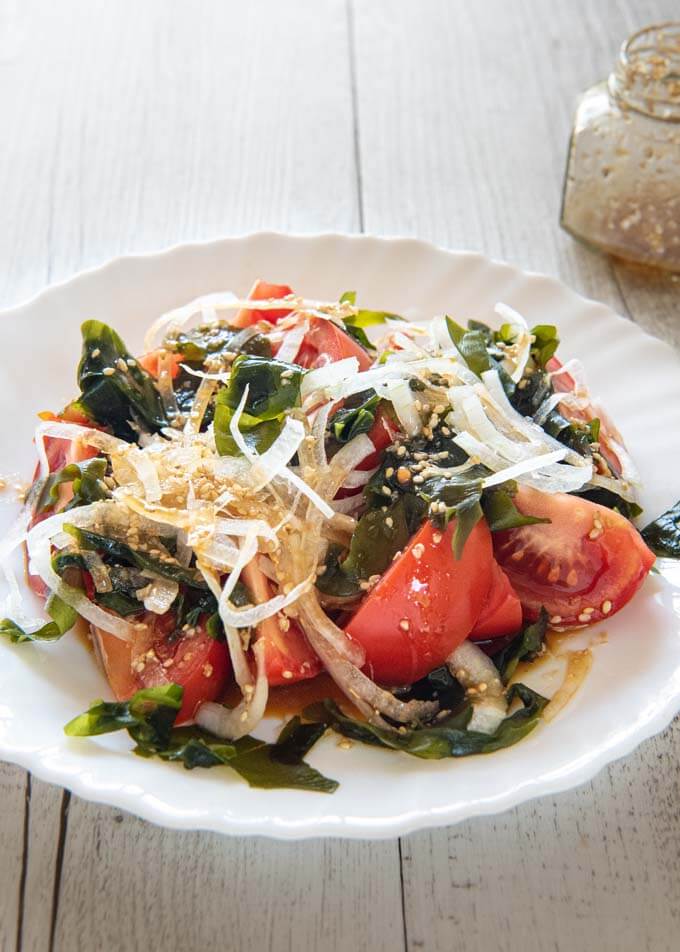
From little kids to elderlies, wakame seaweed is one of the most popular ingredients among Japanese people. The beauty of wakame is that you can eat it without cooking it. I often drop a small handful of wakame seaweed into a bowl of miso soup.
Varieties of Edible Seaweed
Japan is a seaweed kingdom – people eat more than 100 different kinds of seaweed. Use a piece of kelp (konbu) to make dashi stock, make sushi rolls with roasted seaweed sheets (nori), simmer hijiki seaweed with vegetables, etc. The number of dishes you can make with seaweed is endless.
Most seaweed you find at the shops is usually dark green, dark brown or almost black. But do you know that there are reddish seaweeds (red algae) as well? The most commonly consumed red seaweed in Japan is called ‘aka-nori’ (赤海苔), which means red seaweed and ‘tosaka-nori’ (トサカ海苔), which means rooster comb seaweed because of the similarity of the shape and colour to a rooster’s comb.
The photo below shows some of the common seaweeds eaten by Japanese people.
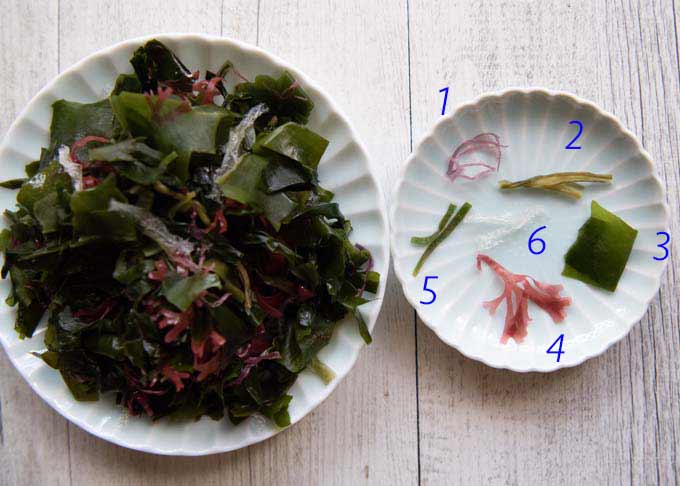
1. aka-nori (red seaweed), 2. mekabu (root of wakame), 3. wakame, 4. tosaka-nori, 5. konbu (kelp), 6. kanten (agar)
A packet of 5 different types of dehydrated seaweeds and kanten flakes (sample photo below) can be purchased at Japanese grocery stores. To eat, simply rehydrate them in water, squeeze the water out and mix with your salad. It even comes with a sachet of dressing.
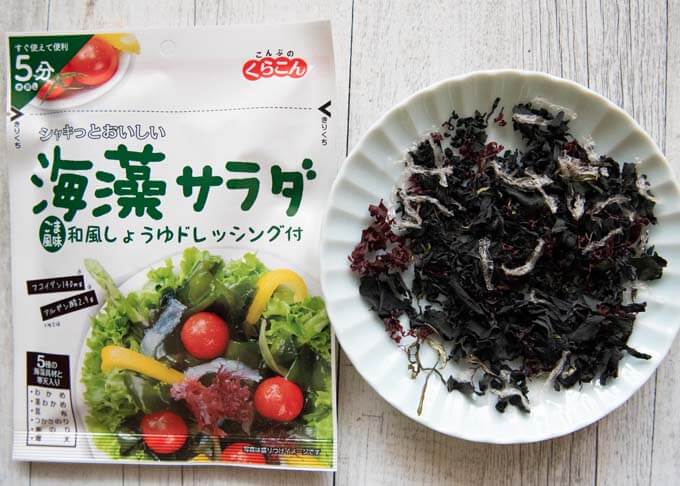
Red seaweed is also served with sashimi along with shredded daikon (white radish) to decorate the plate.
What’s in my Tomato and Seaweed Salad with Sesame Soy Dressing
Unless you are close to a Japanese grocery store, it is not easy to obtain different types of edible seaweeds. So, I used just wakame seaweed today. But if you can get a pack of dried mixed seaweed like the photo above, use that instead.
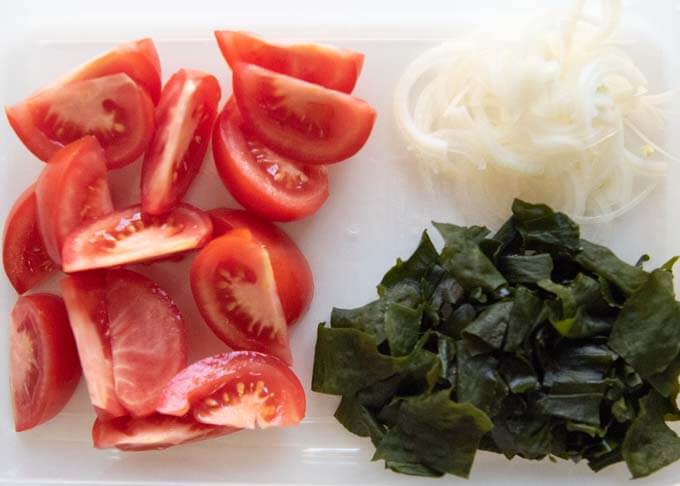
- Tomato
- Wakame seaweed
- Onion
The dressing contains soy sauce and sesame. This distinguishes it from Western style dressings.
- Rice wine vinegar
- Soy sauce
- Vegetable/canola oil
- Sesame oil
- Sugar
- Roasted white sesame seeds
The ratio of the ingredients to make Sesame Soy Dressing is easy to remember. 3 parts each of the first three ingredients and 1 part each of the last three ingredients in the list above.
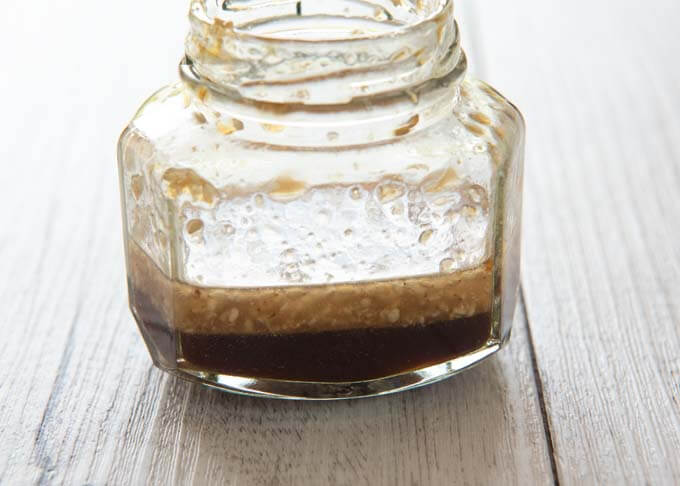
This dressing uses much less oil for the quantity of vinegar than a French dressing for example. But sesame oil makes the dressing somewhat heavy, so I only use 1 quarter of the total oil used in this dressing. If you prefer, you can adjust the proportion of sesame oil and vegetable oil. But I would recommend no more than a 50/50 ratio.
I partially grate roasted white sesame seed to bring out more sesame flavour. You can use s mortar and pestle or, if you happen to have it, use a Japanese sesame grinding tool called ‘gomasuriki’ (胡麻すり器). Gomasuriki works well when you only need a small amount of partially grated sesame seeds. You can buy one at Japanese grocery stores and Daiso discount shops.
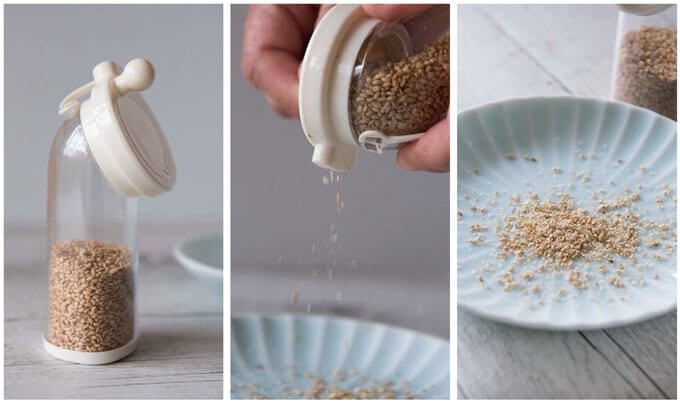
How to Make Tomato and Seaweed Salad with Sesame Soy Dressing
Making today’s salad is very simple. To begin with, you don’t need to cook anything. Just cut the vegetables, mix the dressing ingredients and serve.
- Rehydrate wakame if using dried, and cut into bite size pieces (if it is not pre-cut).
- Cut tomatoes into wedges or slices.
- Slice onion very thinly and remove bitterness by soaking it in water, then drain.
- Mix all the dressing ingredients.
- Plate tomatoes, and wakame seaweed topped with onion slices. Drizzle the dressing over the salad or serve separately.
Slicing onion crosswise makes the slices softer than those sliced lengthwise.
Fresh onion is often very bitter unless you use a variety cultivated for salad. I remove the bitterness by soaking the sliced onion in water for 10 minutes.
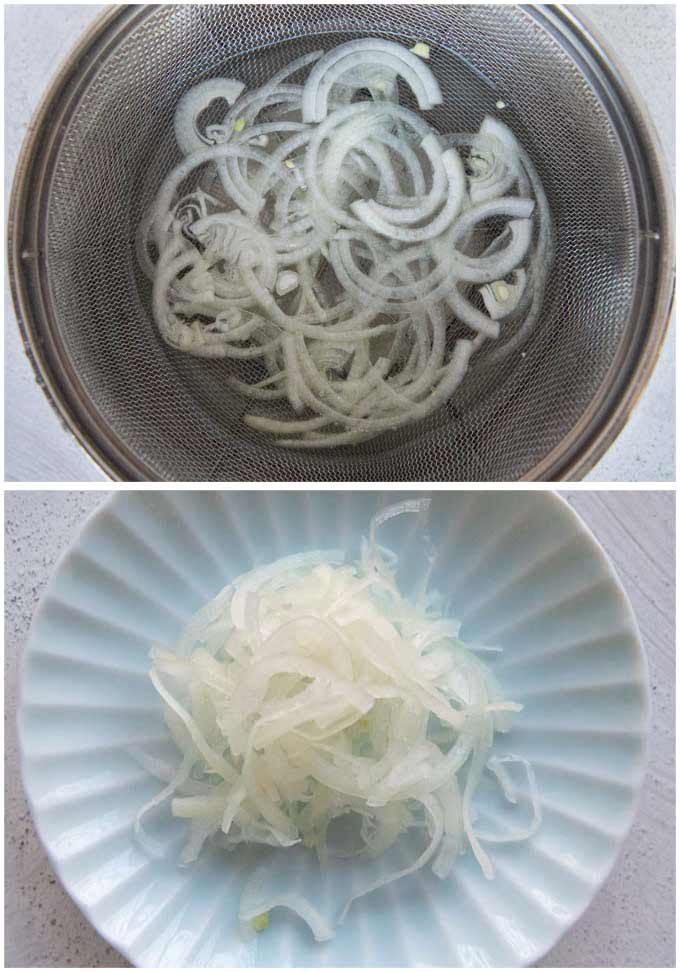
Dried Wakame vs Fresh Wakame
I used frozen salt-preserved fresh wakame seaweed. Here is the packet and one of the long pieces of wakame with salt all over it.
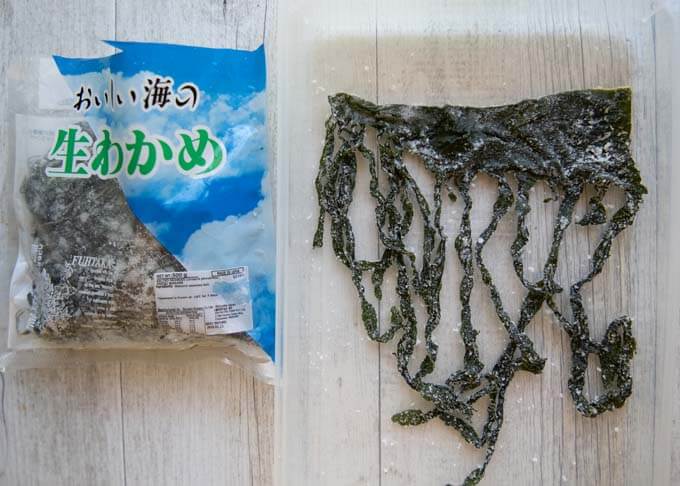
Before using, you need to rinse it to remove the salt and soak in water for a few minutes, then you need to cut it into bite-size pieces. But compared to the dried cut wakame seaweed, which is easier to prepare, this is fresher and tastier. You can buy it frozen at Japanese grocery stores.
You can of course use dried wakame seaweed. These days, you can buy a pack of dried wakame seaweed not only at Japanese/Asian grocery stores but even at supermarkets such as Woolworths and Coles in Australia. Dried wakame seaweed is often already cut to small pieces and all you need to do is to rehydrate them.
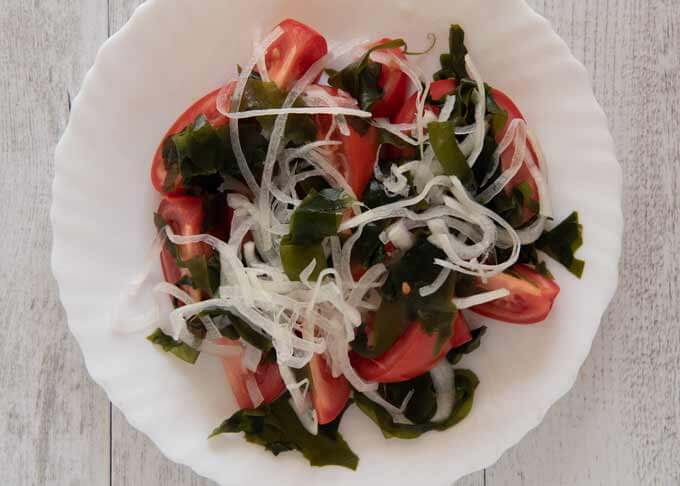
If you like seaweed, I think you will like today’s simple salad. Instead of Sesame Soy Dressing, you can use ponzu dressing (see my post Japanese Dressings) if you want to cut back on the calories.
Yumiko![]()
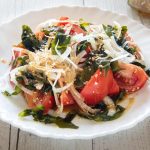
Wakame seaweed is low in calories and high in vitamins and minerals. Combined with tomato wedges, this simple salad gives you so many great nutrients. The sesame dressing brings the natural flavour out of the salad ingredients.
Don't forget to see the section 'MEAL IDEAS' below the recipe card! It gives you a list of dishes that I have already posted and this recipe that can make up a complete meal. I hope it is of help to you.
- 40-50g / 1.4-1.8oz wakame (rehydrated weight, note 1)
- 2 whole tomatoes (medium size, about 300g / 0.7lb in total, note 2)
- 25g / 0.9oz onion or red onion
- 1½ tbsp rice wine vinegar
- 1½ tbsp soy sauce
- 1½ tbsp oil
- ½ tbsp sesame oil
- ½ tbsp sugar
- ½ tbsp roasted white sesame seeds
-
If you are using dehydrated wakame seaweed, soak it in water for 5 minutes, then squeeze the water out. If you are using salted fresh wakame, rinse it to remove salt, then soak in water for few minutes and squeeze the water out.
-
If your wakame seaweed is not pre-cut, cut it into 2-3cm / 2” square pieces.
-
Cut each tomato into 8 wedges (note 2).
-
Slice onion very thinly crosswise and put the slices in a bowl filled with water. Massage the onion slices lightly and leave them in water for 10 minutes. Drain and pat dry with kitchen paper (note 3).
-
Mix all the dressing ingredients in a jar, put a lid on and shake well until the sugar dissolves.
-
Spread the tomato wedges on a plate and scatter the wakame seaweed over the tomatoes. Spread the sliced onions on top. Drizzle the dressing over the salad or serve the dressing separately.
1. 40-50g / 1.4-1.8oz equates to about 4g / 0.14oz of dehydrated (dried) wakame seaweed.
2. I used 2 medium-sized tomatoes so that the size of wedges is not too large. If you are using a large tomato, you may want to cut it differently. Thick slices are good too.
3. This removes the bitterness of the onion. If you are using red onion, you may not have to do this since red onions are usually sweeter.
4. Nutrition per serving. Assumed that 1/3 of the dressing is not consumed.
serving: 223g calories: 217kcal fat: 17g (26%) saturated fat: 1.8g (9%) trans fat: 0.1g polyunsaturated fat: 5.3g monounsaturated fat: 8.6g cholesterol: 0mg (0%) sodium: 623mg (23%) potassium: 489mg (14%) carbohydrates: 15g (5%) dietary fibre: 4.1g (16%) sugar: 6.8g protein: 5.2g vitamin a: 26% vitamin c: 36% calcium: 15% iron: 17%
Meal Ideas
A typical Japanese meal consists of a main dish, a couple of side dishes, a soup and rice. I try to come up with a combination of dishes with a variety of flavours, colours, textures and make-ahead dishes.
The dressing for today’s salad has a prominent sesame and soy flavour containing a bit of oil. I picked Yakibuta (Braised Pork), which is not greasy but goes well with Tomato and Seaweed Salad.
For the side dish, I picked Nasu Dengaku to give a totally different flavour and the texture. Kenchinjiru adds more vegetables to the meal.
- Main: Yakibuta (Braised Pork) – make ahead
- Side dish 1: Miso Glazed Eggplant (Nasu Dengaku) – make ahead dengaku miso
- Side dish 2: Tomato and Seaweed Salad with Sesame Soy Dressing – today’s recipe
- Soup: Japanese Vegetable Soup (Kenchinjiru) – can be made ahead
- Rice: Cooked Rice
 `
`
Excellent flavors! Thank you for this wonderful recipe! 😄
Hi Olga, you are most welcome.
Is the sesame oil toasted sesame oil or just plain clear sesame oil??? Please help!
Hi Lois, unless specifically stated, I use toasted sesame oil, which is dark brown, not clear.
Great sounding dish! Can’t wait to try.
It looks like a unit is missing for the sesame oil quantity. Is it 1/2 tbsp or 1/2 tsp?
Thanks!
Hi Wayne, sorry about missing unit for the sesame oil. It’s 1/2 tbsp and I just fixed it.